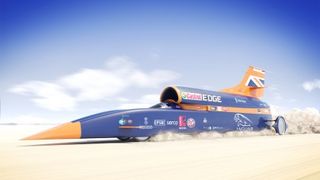Everything you need to know about the 1,000 mph Bloodhound SSC
The brainchild of F1 designers, aerospace engineers, and rocket scientists
The record attempt: there and back again
Setting a new record of 1,000 mph will be attempted in two stages. On October 15, 2016, driver Andy Green will attempt to reach speeds of around 800 mph, breaking his own current land speed record of 763 mph (1,228 kmh). This will be the sighting lap, to make sure everything is working as it should, and uncover any design alterations that may be necessary for the show stopping lap.
The attempt will take place on Hakskeen Pan, which is over 11 miles long and 3 miles wide. Over 300 locals have been employed to clear the runway, shifting 15,800 tonnes of stone by hand.

The Bloodhound SSC will line up on the straight, and slowly move off using the Rolls-Royce jet engine. Once running smoothly Green will activate the jet's afterburner, increasing the fuel mix and boosting thrust to accelerate the car to around 650 mph (1,046 kmh). At this point the Jaguar V8 will engage, pumping in rocket fuel at speed. With the rocket engaged, the Bloodhound SSC will be running at near-maximum speed as it passes the six-mile mark.
After hitting maximum velocity, Green will shut down the engines, allowing the car to naturally decelerate to around 800 mph (1,287 kmh). At this point the car's air brakes will deploy, providing around 3g of braking force. Now below 600 mph (965 kmh), parachutes will deploy, slowing the car even faster.
Once below 250 mph (403 kmh), Green can finally apply the wheel brakes, bringing Bloodhound SSC to a complete stop.
That's not the end of the event. To set a World record, the car must then be refuelled, turned around, and sent back the other way in less than an hour. The average of the two runs will be the official time.

When we asked Richard Noble what it's like to travel at 633 mph (1019 kmh) he replied, "It's just a day job, you have to get on with it really. But it is exhausting."
Get daily insight, inspiration and deals in your inbox
Get the hottest deals available in your inbox plus news, reviews, opinion, analysis and more from the TechRadar team.
How much has it cost?
Bloodhound is a private venture, and by 2017, when the 1,000 mph (1,609 kmh) record is set, the project will have cost around £45 million (around US$68m / AU$97m). Approximately £25 million has been spent researching, designing and engineering the car, and Richard Noble thinks another £17 million will be necessary to complete the project.
Noble is no amateur when it comes to fundraising. He told techradar, "We were the first to do crowdfunding, 10 years ahead of the industry. We had a terrible problem because we needed a million litres of jet fuel but no way to pay for it. We went out to all our followers on the web and asked, 'please will you buy the jet fuel at $25 a go?' In return they got a signed fuel certificate from Andy Green. The fuel flowed at 30,000 gallons a day, it was fantastic."
Next up: the Bloodhound Project
Bloodhound SSC might have started out as a vanity project, but it also has philanthropic and educational goals.

James Painter, Engineering Lead told techradar in 2011, "The Bloodhound Project aims to inspire and encourage the next generation of engineers and scientists that among other things will hopefully help this country and the world deal with the challenges of a low carbon economy.
"Bloodhound is currently engaged with 4,500 Primary and Secondary schools across the UK and has fans in 207 countries worldwide."
That number keeps rising, with 6000 UK primary and secondary schools now signed up to the Bloodhound Education Resources program, and 150 STEM events reaching 100,000 students (aiming for 2.5 million school children by 2018).
Want to watch the world record-breaking attempt? The Bloodhound SSC will have six HD cameras live streaming HD video from Hakskeen Pan.
Current page: The Record Attempt, Cost and The Education Project
Prev Page The Public Debut and onto bigger thingsMost Popular

